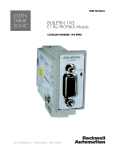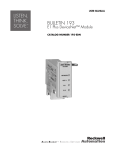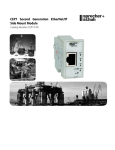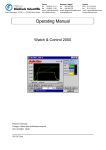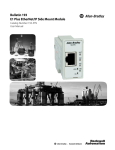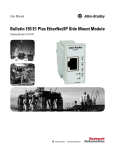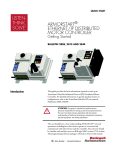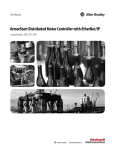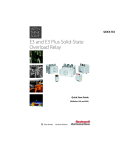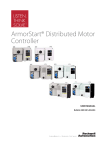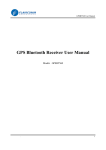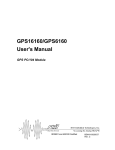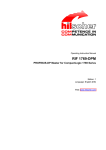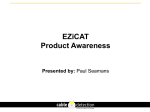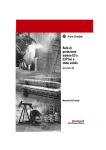Download CEP7-EPRB Profibus Module User Manual
Transcript
USER MANUAL CEP7 Second Generation PROFIBUS Module CATALOG NUMBER CEP7-EPRB Important User Information Solid state equipment has operational characteristics differing from those of electromechanical equipment. Safety Guidelines for the Application, Installation and Maintenance of Solid State Controls (Publication SGI-1.1 available from your local Rockwell Automation sales office or online at http://www.ab.com/manuals/gi) describes some important differences between solid state equipment and hard-wired electromechanical devices. Because of this difference, and also because of the wide variety of uses for solid state equipment, all persons responsible for applying this equipment must satisfy themselves that each intended application of this equipment is acceptable. In no event will Rockwell Automation, Inc. be responsible or liable for indirect or consequential damages resulting from the use or application of this equipment. The examples and diagrams in this manual are included solely for illustrative purposes. Because of the many variables and requirements associated with any particular installation, Rockwell Automation, Inc. cannot assume responsibility or liability for actual use based on the examples and diagrams. No patent liability is assumed by Rockwell Automation, Inc. with respect to use of information, circuits, equipment, or software described in this manual. Reproduction of the contents of this manual, in whole or in part, without written permission of Rockwell Automation, Inc. is prohibited. Throughout this manual, when necessary we use notes to make you aware of safety considerations. WARNING IMPORTANT ATTENTION Identifies information about practices or circumstances that can cause an explosion in a hazardous environment, which may lead to personal injury or death, property damage, or economic loss. Identifies information that is critical for successful application and understanding of the product. Identifies information about practices or circumstances that can lead to personal injury or death, property damage, or economic loss. Attentions help you: • identify a hazard • avoid a hazard • recognize the consequence SHOCK HAZARD Labels may be located on or inside the equipment (e.g., drive or motor) to alert people that dangerous voltage may be present. BURN HAZARD Labels may be located on or inside the equipment (e.g., drive or motor) to alert people that surfaces may be dangerous temperatures. Table of Contents Chapter 1 Installation and Wiring Introduction . . . . . . . . . . . . . . . . . . . . . . . . . . . . . . . . . . . . . . . . . . . . . Features. . . . . . . . . . . . . . . . . . . . . . . . . . . . . . . . . . . . . . . . . . . . . . . . . Installation . . . . . . . . . . . . . . . . . . . . . . . . . . . . . . . . . . . . . . . . . . . . . . Wiring . . . . . . . . . . . . . . . . . . . . . . . . . . . . . . . . . . . . . . . . . . . . . . . . . . Dimensions. . . . . . . . . . . . . . . . . . . . . . . . . . . . . . . . . . . . . . . . . . . . . . 1-1 1-3 1-4 1-5 1-6 Chapter 2 Protection Functions Introduction . . . . . . . . . . . . . . . . . . . . . . . . . . . . . . . . . . . . . . . . . . . . . Trip Status / Identification . . . . . . . . . . . . . . . . . . . . . . . . . . . . . . . . . Trip Resetting . . . . . . . . . . . . . . . . . . . . . . . . . . . . . . . . . . . . . . . . . . . . Trip and Warning Enable . . . . . . . . . . . . . . . . . . . . . . . . . . . . . . . . . . Overload and Phase Loss Protection . . . . . . . . . . . . . . . . . . . . . . . . . Overload Warning . . . . . . . . . . . . . . . . . . . . . . . . . . . . . . . . . . . . . Jam Protection . . . . . . . . . . . . . . . . . . . . . . . . . . . . . . . . . . . . . . . . . . . Jam Trip . . . . . . . . . . . . . . . . . . . . . . . . . . . . . . . . . . . . . . . . . . . . . Jam Warning. . . . . . . . . . . . . . . . . . . . . . . . . . . . . . . . . . . . . . . . . . Underload Protection. . . . . . . . . . . . . . . . . . . . . . . . . . . . . . . . . . . . . . Underload Warning . . . . . . . . . . . . . . . . . . . . . . . . . . . . . . . . . . . . Communication Fault Protection . . . . . . . . . . . . . . . . . . . . . . . . . . . . Comm Fault Warning . . . . . . . . . . . . . . . . . . . . . . . . . . . . . . . . . . Communication Idle Protection . . . . . . . . . . . . . . . . . . . . . . . . . . . . . Comm Idle Warning . . . . . . . . . . . . . . . . . . . . . . . . . . . . . . . . . . . 2-1 2-1 2-1 2-1 2-2 2-2 2-3 2-3 2-4 2-4 2-5 2-5 2-5 2-6 2-6 Chapter 3 PROFIBUS Configuration Introduction . . . . . . . . . . . . . . . . . . . . . . . . . . . . . . . . . . . . . . . . . . . . . 3-1 Acyclic Parameter Access (DP-V1). . . . . . . . . . . . . . . . . . . . . . . . 3-1 Cyclic Parameter Access (DP-V0). . . . . . . . . . . . . . . . . . . . . . . . . 3-2 Initial Data . . . . . . . . . . . . . . . . . . . . . . . . . . . . . . . . . . . . . . . . . . . 3-3 Control- and Status Registers . . . . . . . . . . . . . . . . . . . . . . . . . . . . . . . 3-4 Control Register . . . . . . . . . . . . . . . . . . . . . . . . . . . . . . . . . . . . . . . 3-4 Status Register . . . . . . . . . . . . . . . . . . . . . . . . . . . . . . . . . . . . . . . . 3-5 Parameter Programming . . . . . . . . . . . . . . . . . . . . . . . . . . . . . . . . . . . 3-6 Program Lock . . . . . . . . . . . . . . . . . . . . . . . . . . . . . . . . . . . . . . . . 3-6 Resetting to the Factory Default Values . . . . . . . . . . . . . . . . . . . . 3-6 Parameter Group Listing . . . . . . . . . . . . . . . . . . . . . . . . . . . . . . . . 3-7 Monitor Group . . . . . . . . . . . . . . . . . . . . . . . . . . . . . . . . . . . . . . . 3-8 Advanced Setup Group . . . . . . . . . . . . . . . . . . . . . . . . . . . . . . . . 3-11 Reset/Lock Group. . . . . . . . . . . . . . . . . . . . . . . . . . . . . . . . . . . . 3-14 I/O Setup Group. . . . . . . . . . . . . . . . . . . . . . . . . . . . . . . . . . . . . 3-15 Trip History Group . . . . . . . . . . . . . . . . . . . . . . . . . . . . . . . . . . . 3-17 PROFIBUS Setup Group . . . . . . . . . . . . . . . . . . . . . . . . . . . . . . 3-18 iii Publication CEP7-UM010A-EN-P – January 2008 iv Chapter 4 Troubleshooting Introduction . . . . . . . . . . . . . . . . . . . . . . . . . . . . . . . . . . . . . . . . . . . . . PROFIBUS Modes of Operation . . . . . . . . . . . . . . . . . . . . . . . . . . . . Power-Up Mode . . . . . . . . . . . . . . . . . . . . . . . . . . . . . . . . . . . . . . Run Mode. . . . . . . . . . . . . . . . . . . . . . . . . . . . . . . . . . . . . . . . . . . . Configuration Error Mode . . . . . . . . . . . . . . . . . . . . . . . . . . . . . . Fatal Error Mode . . . . . . . . . . . . . . . . . . . . . . . . . . . . . . . . . . . . . . PROFIBUS Troubleshooting Procedures . . . . . . . . . . . . . . . . . . . . . Network Status LED . . . . . . . . . . . . . . . . . . . . . . . . . . . . . . . . . . . DP-V1 Error Codes. . . . . . . . . . . . . . . . . . . . . . . . . . . . . . . . . . . . Input and Output Troubleshooting Procedures. . . . . . . . . . . . . . . . . Trip and Warning Troubleshooting Procedures. . . . . . . . . . . . . . . . . Appendix A - Specifications . . . . . . . . . . . . . . . . . . . . . . . . . . . . . . . . . . . . . . . . . . . . . . . . . . . . . . . A-1 Appendix B PROFIBUS Information Structure of the "Set Prm Data"-telegram . . . . . . . . . . . . . . . . . . . . . B-2 Electronic Data Sheet . . . . . . . . . . . . . . . . . . . . . . . . . . . . . . . . . . . . . B-3 Set Slave Address . . . . . . . . . . . . . . . . . . . . . . . . . . . . . . . . . . . . . . . . . B-3 Supported Baud Rates . . . . . . . . . . . . . . . . . . . . . . . . . . . . . . . . . . . . . B-3 PROIFIBUS Identity . . . . . . . . . . . . . . . . . . . . . . . . . . . . . . . . . . . . . . B-4 Identification and Maintenance (I&M) . . . . . . . . . . . . . . . . . . . . . B-4 Publication CEP7-UM010A-EN-P – January 2008 4-1 4-2 4-2 4-2 4-3 4-3 4-4 4-4 4-5 4-6 4-8 Chapter 1 Installation and Wiring Introduction The purpose of this chapter is to provide the necessary instructions to successfully install a CEP7-EPRB PROFIBUS Module to an CEP7 Second Generation Overload Relay and properly connect to a PROFIBUS network. ATTENTION ATTENTION ATTENTION ATTENTION ATTENTION ATTENTION 1 To prevent electrical shock, disconnect from power source before installing or servicing. Install in suitable enclosure. Keep free from contaminants. The side mount module contains ESD (electrostatic discharge) sensitive parts and assemblies. Static control precautions are required when installing, testing, servicing, or repairing this assembly. Component damage may result if ESD control procedures are not followed. If you are not familiar with static control procedures, refer to Rockwell Automation publication 8000-4.5.2, “Guarding Against Electrostatic Damage”, or any other applicable ESD protection handbook. The purpose of this document is to serve as a guide for proper installation. The National Electrical Code and any other governing regional or local code will take precedence. Rockwell Automation cannot assume responsibility for the compliance or proper installation of the side mount module or associated equipment. A hazard of personal injury and/or equipment damage exists if codes are ignored during installation. An incorrectly applied or installed side mount module can result in damage to the components or reduction in product life. Wiring or application errors such as supplying incorrect or inadequate supply voltage, or operating/storing in excessive ambient temperatures may result in malfunction of the product. Only personnel familiar with the side mount module and associated machinery should plan to install, set up, and maintain the system. Failure to comply may result in personal injury and/or equipment damage. This is a Class A product. In a domestic environment, this product may cause radio interference, in which case, the user may be required to take adequate measures. Publication CEP7-UM010A-EN-P – January 2008 1-2 Installation and Wiring Features Figure 1.1 Features Network Status LED PROFIBUS Connector Power Supply Connector I/O Connector Installation Figure 1.2 Installation [1] Figure 1.3 Installation [2] #2 Driver 0.7 - 1.1 N . m (6 - 10 lb-in) Figure 1.4 Installation [3] 7mm (.28 in) 0.6mm X 3.5mm Blade (.02 in X .14 in Blade) 0.5 - 0.6 N . m (4.4 - 5.3 lb-in) Publication CEP7-UM010A-EN-P – January 2008 Installation and Wiring 1-3 Wiring Table 1.1 Wire and Size Torque Specifications 1X 2X 24…12 AWG 24…16 AWG 5 lb.-in 1X 2X 0.2…2.5 mm2 0.25…1 mm2 0.55 N•m 1X 2X 0.2…2.5 mm2 0.2…1 mm2 0.55 N•m Figure 1.5 Wiring Diagram 6 NC NC B-Line RTS GND BUS +5V BUS OUT NC A-Line NC SHIELD A2 ( -) OUTA (B300) (20.4 - 26.4 VDC) 3 A1 (+) SSV 2 9 1. 2. 3. 4. 5. 6. 7. 8. 9. Housing 1 IN2 13 14 1 5 IN1 Publication CEP7-UM010A-EN-P – January 2008 1-4 Installation and Wiring Dimensions Figure 1.6 Dimension Diagram J H A F G E K B D L C Table 1.2 Dimension Specifications Contactor Cat. No. CEP7 Second Gen. Cat. No. CA7-9, -12, -16, -23 CEP7-EE_ B CA7-30, -37 CEP7-EE_ D CA7-43 CA7-60, -72, -85 CEP7-EE_ E A B C D E F G H J K L mm (in) 67 (2.64) 148 (5.83) 85.2 (3.35) 24.5 (.96) 13.9 (.55) 35 (1.38) 60 (2.36) 86.5 (3.40) 2 (.08) 4.5 (.17) 22 (.86) mm (in) 67 (2.64) 148 (5.83) 101.2 (3.98) 24.5 (.96) 13.9 (.55) 35 (1.38) 60 (2.36) 104 (4.09) 2 (.08) 4.5 (.17) 22 (.86) mm (in) 71.5 (2.82) 148 (5.83) 101.2 (3.98) 24.5 (.96) 18.4 (.74) 45 (1.77) 60 (2.36) 104 (4.09) 2 (.08) 4.5 (.17) 22 (.86) mm (in) 94 (3.70) 191.6 (7.54) 120.4 (4.74) 29 (1.14) 23.8 (.94) 55 (2.16) 100 (3.94) 126 (4.94) 2 (.08) 5.4 (.21) 22 (.86) Publication CEP7-UM010A-EN-P – January 2008 Chapter 2 Protection Functions Introduction The purpose of this chapter is to provide detailed information regarding the protective trip and warning functions that the CEP7-EPRB PROFIBUS Module adds to the CEP7 Second Generation Overload Relay. In this chapter, you will find considerable mention given to parameters as they relate to these functions. For complete descriptions of the programming parameters, refer to Chapter 3 - Profibus Configuration. Trip Status / Identification The PROFIBUS Module determines trip status and identification through monitoring of reference signals inside the CEP7 Second Generation Overload Relay. On power-up, it assumes that the CEP7 Second Generation Overload Relay is in a non-tripped condition. For definitive feedback on trip status of the CEP7 Second Generation Overload Relay, one of the PROFIBUS module inputs may be wired to the N.O. auxiliary contact (terminals 97 and 98) of the CEP7 Second Generation Overload Relay. Parameters 28 and 29 are used to configure the assignment of the inputs. For this function, use the “OL Contact” configuration. Trip Resetting The following options are available for resetting a tripped CEP7 Second Generation Overload Relay with a PROFIBUS module: • Blue mechanical reset button located on the front of the CEP7 Second Generation Overload Relay • Setting Parameter 19, Trip Reset, to “Reset” • Setting the "Trip Reset"-bit bit in the Control Register • Using a push button (N.O. contact configuration) wired to one of the PROFIBUS Module inputs, programming the corresponding input assignment parameter (28 or 29) to “Trip Reset” IMPORTANT Trip and Warning Enable Setting parameter 11, Reset Mode, to “Automatic” does not result in other reset commands being ignored. Parameter 8, Trip Enable, allows the installer to enable or disable the jam trip protective function. Parameter 9, Warning Enable, allows the installer to enable or disable the overload, jam and underload warning protective functions. ATTENTION Overload and Phase Loss Protection 1 The Trip Enable settings should not be altered during machine operation, as unexpected behavior could occur. This may result in an unintended actuation of controlled industrial equipment, with the potential for machine damage or serious injury to personnel. Thermal overload and phase loss trip protection is provided exclusively by the CEP7 Second Generation Overload Relay. The CEP7 Second Generation Overload Relay provides uninterrupted protection to the motor, even in the event of a PROFIBUS Module failure. Publication CEP7-UM010A-EN-P – January 2008 2-2 Protection Functions Settings for FLA and trip class are found directly on the CEP7 Second Generation Overload Relay. IMPORTANT The reset mode DIP switch adjustment is overridden by the PROFIBUS module parameter 11, OL Reset Mode, while the PROFIBUS module is powered. Overload Warning The PROFIBUS Module continuously monitors the CEP7 Second Generation Overload Relay's percentage of thermal utilization signal. Parameter 2,%Therm Utilized, provides this value. Parameter 12, OL Warning Level, is used to adjust the setpoint to alert for an impending overload trip and is adjustable from 0…100% TCU. The PROFIBUS Module will indicate an overload warning if all the following conditions are met: • No warning currently exists • Overload warning is enabled • %Therm Utilized is equal to or greater than OL Warning Level When the overload warning conditions are satisfied, the following will occur: • Bit 0 in Parameter 4, Warning Status, will go to “1” • Bit 1 of Parameter 5, Device Status, will go to “1” IMPORTANT Jam Protection %Therm Utilized will stabilize at a value of approximately 88% with the motor operating continuously at rated current. Motor current greater than the motor's nameplate rating can indicate a high overload or stall condition, such as an overloaded conveyor or jammed gear. These conditions can result in overheating of the motor, and equipment damage. Rapid jam fault detection helps to minimize damage and loss of production. By continuously monitoring the motor current level signal as a percentage of the CEP7 Second Generation Overload Relay's dial FLA setting, the PROFIBUS module allows jam trip and warning capability. Jam Trip The following parameters are available for configuring the PROFIBUS Module's jam trip performance: • Parameter 13, Jam Inhibit Time, allows the installer to inhibit a jam trip from occurring during the motor starting sequence. It is adjustable from 0…250 seconds. • Parameter 14, Jam Trip Delay, allows the installer to define the time period a jam condition must be present before a trip occurs. It is adjustable from 0.5…25.0 seconds. • Parameter 15, Jam Trip Level, allows the installer to define the current at which the CEP7 Second Generation Overload Relay will trip on a jam. It is user-adjustable from 150…600% of the FLA dial setting. Publication CEP7-UM010A-EN-P – January 2008 Protection Functions 2-3 The PROFIBUS Module will command the CEP7 Second Generation Overload Relay to trip if all the following conditions are met: • • • • No trip currently exists Jam Protection is enabled Jam Inhibit Time has expired The motor current is greater than the Jam Trip Level for a time period greater than the Jam Trip Delay When the conditions for a jam trip are satisfied, the following will occur: • • • • Bit 2 in Parameter 3, Trip Status, will go to “1” Bit 0 in Parameter 5, Device Status, will go to “1” The CEP7 Second Generation Overload Relay's trip relay contacts (95 and 96) will open Out A will be placed in their Protection Fault State (if so programmed) IMPORTANT IMPORTANT The Protection Fault State of OUT A is defined by parameter 22 (OUTA Pr FltState) and parameter 23 (OUTA Pr FltValue). The jam inhibit timer starts after the load current transitions from 0 A to 30% FLA. The PROFIBUS Module does not begin monitoring for a jam condition until the Jam Inhibit Time expires. Jam Warning Parameter 16, Jam Warn Level, allows the installer to define the current at which the PROFIBUS Module will indicate a warning. It is user-adjustable from 100…600% FLA. The PROFIBUS Module will indicate a Jam warning if: • • • • No warning currently exists Jam Warning is enabled Jam Inhibit Time has expired The motor current is equal to or greater than the Jam Warn Level When the Jam Warning conditions are satisfied, the following will occur: • Bit 2 in Parameter 4, Warning Status, will go to “1” • Bit 1 in Parameter 5, Device Status, will go to “1” IMPORTANT Underload Protection The Jam Warning function does not include a time delay feature. Once the Jam Inhibit Time has expired, the Jam Warning indication is instantaneous. Motor current less than a specific level may indicate a mechanical malfunction in the installation, such as a torn conveyor belt, damaged fan blade, broken shaft, or worn tool. Such conditions may not harm the motor, however, rapid detection may help to minimize equipment damage and loss of production. Publication CEP7-UM010A-EN-P – January 2008 2-4 Protection Functions Underload Warning The following parameters are available for configuring the PROFIBUS Module's underload warning performance: • Parameter 17, UL Inhibit Time, allows the installer to inhibit an underload indication from occurring during the motor starting sequence. It is adjustable from 0…250 seconds. • Parameter 18, UL Warn Level, allows the installer to define the current at which the PROFIBUS Module will indicate a warning. It is user-adjustable from 30…100% of the FLA dial setting. The PROFIBUS Module will immediately indicate an Underload warning if: • • • • No warning currently exists Underload Warning is enabled UL Inhibit Time has expired The motor current is less than the UL Warn Level When the Underload Warning conditions are satisfied, the following will occur: • Bit 3 in Parameter 4, Warning Status, will go to “1” • Bit 1 of Parameter 5, Device Status, will go to “1” IMPORTANT Communication Fault Protection The Underload Warning function does not include a time delay feature. Once the UL Inhibit Time has expired, the Underload warning indication is instantaneous. A disruption of the communication link between the CEP7 Second Generation PROFIBUS Module and a PROFIBUS network can result in the loss of application control and/or critical process diagnostic data. Rapid communication fault detection helps minimize potential damage due to uncontrolled or unmonitored applications. Comm Fault Warning The PROFIBUS Module will indicate a Comm Fault warning if: • No warning currently exists • Comm Fault Warning is enabled • The PROFIBUS Module experiences a loss of communication When the Comm Fault warning conditions are satisfied, the following will occur: • The Network Status LED will go out • Bit 5 in Parameter 4, Warning Status, will go to “1” • Bit 1 of Parameter 5, Device Status, will go to “1” IMPORTANT Communication Idle Protection Publication CEP7-UM010A-EN-P – January 2008 The Comm Fault State of OUT A is defined by Parameter 24 (OUTA Pb FltState) and parameter 25 (OUTA Pb FltValue). When a programmable controller is placed into the program mode, the execution of its ladder program is suspended, and any connected networks go to an idle state. If inadvertent, this can result in the loss of application control and/or critical process diagnostic data. Rapid Protection Functions 2-5 communication idle detection helps minimize the potential damage due to uncontrolled or unmonitored applications. Comm Idle Warning The PROFIBUS Module will indicate a Comm Idle warning if: • No warning currently exists • Comm Idle Warning is enabled • The PROFIBUS module is in idle (clear) mode When the Comm Idle warning conditions are satisfied, the following will occur: • Bit 6 in Parameter 4, Warning Status, will go to “1” • Bit 1 in Parameter 5, Device Status, will go to “1” IMPORTANT The Comm Idle State of OUT A is defined by Parameter 26 (OUTA Pb IdlState) and parameter 27 (OUTA Pb IdlValue). Publication CEP7-UM010A-EN-P – January 2008 2-6 Protection Functions Publication CEP7-UM010A-EN-P – January 2008 Chapter 3 PROFIBUS Configuration Introduction The PROFIBUS Module supports DP-V0 and DP-V1 communications. It is commissioned for a PROFIBUS network using a GSD file which contains information about parameters, profiles, I/O types, and sizes specific for this module. The GSD file for the CEP7-EPRB can be dowloaded from http://www.ab.com/networks/gsd/. Acyclic Parameter Access (DP-V1) The preferred way of accessing device parameters is by means of Acyclic (DP-V1) read- and write services. When accessed acyclically, parameters are addressed by their corresponding Index (index equals parameter number). Note that due to technical reasons imposed by the PROFIBUS networking system, it is required to map at least one byte of Cyclic I/O in either direction. Any parameter can be used for this purpose. Note: The slot number is not significant (i.e. it’s ignored by the module) IMPORTANT IMPORTANT IMPORTANT Write requests towards writeable parameters will automatically cause the corresponding setting to be saved in non volatile memory. For consistency reasons, all parameters mapped as Cyclic I/O will be read-only when accessed acyclically. Changes made to parameter values will take effect immediately even during a “running” status. Parameter setting changes made in a PROFIBUS configuration tool do not take effect in the PROFIBUS Module until the installer applies or downloads the new settings to the device. Cyclic Parameter Access (DP-V0) All parameters can be accessed cyclically by adding the corresponding GSD-module to the network configuration. GSD-modules can be added (i.e. mapped as Cyclic I/O) as needed, in any order, with a few restrictions: • At least one byte must be mapped as Cyclic I/O. This can either be device parameters or - the Control- and Status Registers. • It is not permitted to map the same parameter to the Cyclic I/O configuration more than once. • Parameters mapped as Cyclic I/O cannot be written using Acyclic (DP-V1) services. IMPORTANT 1 For technical reasons, writeable parameters mapped as Cyclic I/O will not be saved automatically in non volatile memory. To save such paramaters, a save operation must explicitly be triggered by means of a bit in the Control Register. Publication CEP7-UM010A-EN-P – January 2008 3-2 PROFIBUS Configuration All changes made to parameter values, saved or not, will take effect immediately even during Data Exchange. IMPORTANT Initial Data During startup of the network, it is possible to load start-up values (loaded on each transition from offline to online) for all writable parameters by means of the User Prm Data. The PROFIBUS Module will use these settings provided that "Parameter Initialization" (User Prm Data byte #3) is set as "Enabled". Note that this will result in any previous settings stored in non volatile memory to be replaced. Initial values supplied through the User Prm Data will only be used if all initial parameter values are valid. In case an illegal initial parameter value is specified, an out-of-range parameter error will be signalled to the PROFIBUS master. The loading of initial data also includes the "Program Lock"-setting, which means that it is possible to specify a default configuration during startup, which will then be protected from write access during runtime. Initial values supplied through the User Prm Data will only be used if all initial parameter values are valid. In case an illegal initial parameter value is specified, an out-of-range parameter error will be signalled to the PROFIBUS master. IMPORTANT Special care has to be taken for parameters mapped as Cyclic I/O, since their value may be overwritten during the first bus cycle. This can be prevented using parameter 20 (Program Lock), however as soon as the Program Lock is disabled, the value of these parameters will be replaced by the corresponding I/O data. IMPORTANT Control- and Status Registers A special GSD-module (labelled "193-EPRB") is used to house the Control- and Status Registers. These registers controls- and reflects the overall status of the module respectively. Control Register The structure controls various aspects of the module as follows: Table 3.1 Control Register contents Bit 7 6 5 4 3 Function: 2 1 0 X X Trip Reset X X Publication CEP7-UM010A-EN-P – January 2008 OutA Save X X X X Not Used PROFIBUS Configuration 3-3 • Bit 0; OutA – Control of the Output relay. The bit is flank triggered, i.e. a state transition from 0 to 1 or from 1 to 0 must be performed to change the state of the relay • Bit 2; Trip Reset – Same functionality as parameter 19, Trip Reset. The bit is flank triggered, i.e. a state transition from 0 to 1 must be performed to trigger a trip reset. • Bit 6; Save – Used to trigger a save (to non-volatile memory) of parameter values of parameters that are mapped as Cyclic I/O. The bit is flank triggered, i.e. a state transition from 0 to 1 must be performed to trigger a save operation. Status Register The Status Register reflects the overall status of the module as follows: Table 3.2 Status Register contents Bit 7 6 5 4 3 Function: 2 1 0 X X X X X X X X Trip Warning OutA Stat Not Used Input 1 Input 2 Save Ready Motor Curr. • Bit 0 Trip – Same functionality as bit 0 in parameter 5, Device Status. • Bit 1 Warning – Same functionality as bit 1 in parameter 5, Device Status. • Bit 2 OutA Stat – Same functionality as bit 2 in parameter 5, Device Status. • Bit 4 Input 1 – Same functionality as bit 3 in parameter 5, Device Status. • Bit 5 Input 2 – Same functionality as bit 4 in parameter 5, Device Status. • Bit 6 Save Ready – Used to indicate that a save of parameter values of parameters mapped as Cyclic I/O has been performed. The bit can be cleared again by clearing the "Save"-bit in the Control Register. • Bit 7 Motor Current – Same functionality as bit 5 in parameter 5, Device Status. Publication CEP7-UM010A-EN-P – January 2008 3-4 PROFIBUS Configuration Parameter Programming Program Lock Parameter 20, Program Lock, provides a degree of security from having parameter settings unintentionally altered when programmed to the “locked” setting. If enabled, all parameters except Program Lock (20) are protected from acyclic (DP-V1) write access, and any changes made to the value of parameters mapped as Cyclic I/O will be ignored. The "Program Lock" parameter will, if mapped as Cyclic I/O, be processed prior to processing other parameters mapped as Cyclic I/O. The loading of initial data is not affected by the Program Lock. Resetting to the Factory Default Values Parameter 25, Set to Defaults, allows the installer to reset all parameter settings (including trip logs) to the factory default values. IMPORTANT Resetting to factory default values also resets the node address of the PROFIBUS module to its default value of 126. Parameter Group Listing The CEP7-EPRB PROFIBUS Module contains six parameter groups: Table 3.3 Parameter Groups Monitor parameters Advanced Setup Reset/Lock I/O Setup Trip History PROFIBUS Setup 1 Average %FLA 8 Trip Enable 19 Trip Reset 22 OutA Pr FltState 30 Trip Log 0 35 SSA Node Address 2%Therm Utilized 9 Warning Enable 20 Program Lock 23 OutA Pr FltValue 31 Trip Log 1 3 Trip Status 10 Single/Three Ph 21 Set to Defaults 24 OutA Pb FltState 32 Trip Log 2 4 Warning Status 11 OL Reset Mode 25 OutA Pb FltValue 33 Trip Log 3 5 Device Status 12 OL Warning Level 26 OutA Pb IdlState 34 Trip Log 4 6 Firmware Revision 13 Jam Inhibit Time 27 OutA Pb IdlValue 7 Serial Number 14 Jam Trip Delay 28 IN1 Assignment 15 Jam Trip Level 29 IN2 Assignment 16 Jam Warn Level 17 UL Inhibit Time 18 UL Warn Level Publication CEP7-UM010A-EN-P – January 2008 PROFIBUS Configuration 3-5 Monitor Group Average %FLA Index No. 1 This parameter reports the average motor current. The value is reported as a percentage of motor rated current (dial setting on the CEP7 Second Generation Overload Relay), and is reported in increments of 5. Access Rule Read 14 13 12 11 10 9 8 X X X X X 14 13 12 11 10 9 8 0 Max. Value 1275 Default Value None 2 Read Size 1 byte Group Monitor Units % Min. Value 0 Max. Value 100 Default Value None Trip Status Index No. 3 This parameter provides trip identification. 1 = Trip 0 = No Trip Access Rule Read 7 X Size 2 bytes Group Monitor Units — Min. Value — Max. Value — Default Value None Function: 6 5 4 3 2 1 0 X X X Overload Phase Loss Jam X Not Used Warning Status Index No. 4 This parameter provides warning identification 1 = Warning 0 = No Warning Access Rule Read Bit 15 %FLA Min. Value Index No. X X Units Access Rule X X Monitor This parameter reports the percent thermal utilization of the connected motor. X X 2 bytes Group % Therm Utilized Bit 15 Size 7 Size 2 bytes Group Monitor Units — Min. Value — Max. Value — Default Value None Function: 6 5 4 3 2 1 0 X X X Overload Not Used Jam Publication CEP7-UM010A-EN-P – January 2008 3-6 PROFIBUS Configuration Bit 15 14 13 12 11 10 9 8 7 Function: 6 5 4 3 2 1 0 X Underload X Not Used X Comm Fault X Comm Idle X X X X X X X X Nonvolatile Memory Fault X Not Used Device Status Index No. 5 This parameter provides status information related to the CEP7 Second Generation Overload Relay and the PROFIBUS Module. 1 = On or Present 0 = Off or Not Present Access Rule Read Bit 15 14 13 12 11 10 9 8 7 6 5 4 3 2 1 X X X X X X X X X Publication CEP7-UM010A-EN-P – January 2008 X X Monitor Units — Min. Value — Max. Value — Default Value None 0 X X 2 bytes Group Function: X X Size X Trip Warning Out A In 1 In 2 Motor Current Not Used Firmware Revision Index No. 6 This parameter reports the firmware revision of the PROFIBUS Module. Format: 0x0107 equals version 1.07 Access Rule Read Size 2 bytes Group Monitor Units — Min. Value 0 Max. Value 65535 Default Value None Serial Number Index No. 7 This parameter reports the serial number assigned during production of the PROFIBUS Module. Access Rule Read Size 4 bytes Group Monitor Units — Min. Value 0 Max. Value 0xFFFFFFFF Default Value None PROFIBUS Configuration 3-7 Advanced Setup Group Trip Enable Index No. 8 This parameter allows the installer to enable or disable the Jam Trip function 1 = Enabled 0 = Disabled Access Rule Read/Write Size 2 bytes Group Advanced Setup Units — Min. Value 0000000000000000 Max. Value 0000000000000100 Default Value 0000000000000000 Bit 15 14 13 12 11 10 9 8 7 Function: 6 5 4 3 2 1 0 X Not Used X Not Used X X X X X X X X X X X X X Jam X Not Used Warning Enable Index No. 9 This parameter allows the installer to enable or disable the warning functions separately. All warning functions are disabled from the factory. 1 = Enabled 0 = Disabled Access Rule Read/Write Size 2 bytes Group Advanced Setup Units — Min. Value 0000000000000000 Max. Value 0000000001101101 Default Value 0000000000000000 Bit 15 14 13 12 11 10 9 8 7 Function: 6 5 4 3 2 1 0 X Overload X Not Used X Jam X Underload X Not Used X Comm Fault X X X X X X X X X Comm Idle X Not Used Single/Three Ph Index No. 10 This parameter configures the PROFIBUS Module for singleor three-phase application. This parameter should be set to “Single Phase" when CEP7S devices are employed. Access Rule Read/Write Size 1 byte Group Advanced Setup Units — Min. Value 0 = Single-Phase Max. Value 1 = Three-Phase Default Value 1 Publication CEP7-UM010A-EN-P – January 2008 3-8 PROFIBUS Configuration Publication CEP7-UM010A-EN-P – January 2008 OL Reset Mode Index No. 11 This parameter defines whether a trip can be automatically or manually reset. This setting overrides the CEP7 Second Generation DIP switch adjustment while the PROFIBUS Module is powered. Note, however, that the CEP7 Second Generation manual reset button, accessible at the front, is always active. Access Rule Read/Write Size 1 byte Group Advanced Setup Units — Min. Value 0 = Manual Max. Value 1 = Automatic Default Value 0 OL Warning Level Index No. 12 This parameter sets the overload warning level. Access Rule Read/Write Size 1 byte Group Advanced Setup Units % Thermal Utilization Min. Value 0 Max. Value 100 Default Value 90 Jam Inhibit Time Index No. 13 This parameter defines the amount of time for which jam detection is inhibited during a motor starting sequence. Access Rule Read/Write Size 1 byte Group Advanced Setup Units Seconds Min. Value 0 Max. Value 250 Default Value 10 Jam Trip Delay Index No. 14 This parameter allows the installer to program a time duration for which a jam condition must exist at the programmed level prior to the device tripping. Access Rule Read/Write Size 1 byte Group Advanced Setup Units Seconds Min. Value 0.5 Max. Value 25.0 Default Value 5.0 Jam Trip Level Index No. 15 This parameter sets the jam trip level. Access Rule Read/Write Size 2 bytes Group Advanced Setup Units % FLA Min. Value 150 Max. Value 600 Default Value 250 PROFIBUS Configuration Jam Warn Level Index No. 16 This parameter sets the jam warning level. Access Rule Read/Write Size 2 bytes Group Advanced Setup Units % FLA Min. Value 100 Max. Value 600 Default Value 150 UL Inhibit Time Index No. 17 This parameter defines the amount of time for which underload detection is inhibited during a motor starting sequence. Access Rule Read/Write Size 1 byte Group Advanced Setup Units Seconds Min. Value 0 Max. Value 250 Default Value 10 UL Warn Level Index No. 18 This parameter sets the underload warning level. Access Rule Read/Write Size 1 byte Group Advanced Setup Units % FLA Min. Value 30 Max. Value 100 Default Value 70 3-9 Reset/Lock Group Trip Reset Index No. 19 This parameter provides the user with the capability of resetting a trip over the PROFIBUS network. After a trip is reset, the parameter automatically returns to a “Ready” state. Access Rule Read/Write Size 1 byte Group Reset/Lock Units — Min. Value 0 = Ready Max. Value 1 = Reset Trip Default Value 0 Program Lock Index No. 20 This parameter prohibits the device parameters from being altered when set to “Locked”. It must be set to “Unlocked” to allow parameter modification. Access Rule Read/Set Size 1 byte Group Reset/Lock Units — Min. Value 0 = Unlocked Max. Value 1 = Locked Default Value 0 Publication CEP7-UM010A-EN-P – January 2008 3-10 PROFIBUS Configuration Set To Defaults Index No. 21 This parameter allows the user to reset the parameter settings to the factory default values. After parameter values have been reset to the factory default settings, the parameter automatically returns to a “Ready” state. Access Rule Read/Write Size 1 byte Group Reset/Lock Units — Min. Value 0 = Ready Max. Value 1 = Reset Defaults Default Value 0 I/O Setup Group Publication CEP7-UM010A-EN-P – January 2008 OutA Pr FltState Index No. 22 This parameter, in conjunction with parameter 23, defines how Output A will respond when a trip occurs. When set to “1”, Output A will continue to operate as commanded via the network. When set to “0”, Output A will open or close as determined by the setting of parameter 23. Access Rule Read/Write Size 1 byte Group I/O Setup Units — Min. Value 0 = Go To FltValue (#23) Max. Value 1 = Ignore Fault Default Value 0 OutA Pr FltValue Index No. 23 This parameter determines the state that Output A assumes when a trip occurs and Parameter 22 is set to “0”. Access Rule Read/Write Size 1 byte Group I/O Setup Units — Min. Value 0 = Open Max. Value 1 = closed Default Value 0 OutA Pb FltState Index No. This parameter, in conjunction with Parameter 25, defines how Output A will respond when a PROFIBUS network fault occurs. When set to “1”, Output A will hold the state prior to PROFIBUS fault occurrence. When set to “0”, Output A will open or close as determined by the setting of Parameter 25. Access Rule 24 Read/Write Size 1 byte Group I/O Setup Units — Min. Value 0 = Go To FltValue (#25) Max. Value 1 = Hold Last State Default Value 0 OutA Pb FltValue Index No. 25 This parameter determines the state that Output A assumes when a PROFIBUS network fault occurs and Parameter 24 is set to “0”. Access Rule Read/Write Size 1 byte Group I/O Setup Units — Min. Value 0 = Open Max. Value 1 = Closed Default Value 0 PROFIBUS Configuration OutA Pb IdlState Index No. 26 This parameter, in conjunction with parameter 27, defines how Output A will respond when the PROFIBUS network is idle. When set to “1”, Output A will hold the state prior to PROFIBUS fault occurrence. When set to “0”, Output A will open or close as determined by the setting in Parameter 27. The Pb Flt parameters supersede the Pb Idl parameters. Access Rule Read/Write Size 1 byte Group I/O Setup Units — Min. Value 0 = Go To IdlValue (#27) Max. Value 1 = Hold Last State Default Value 0 OutA Pb IdlValue Index No. 27 This parameter determines the state that Output A assumes when the network is idle and parameter 26 is set to “0”. Access Rule Read/Write Size 1 byte Group I/O Setup Units — Min. Value 0 = Open Max. Value 1 = Closed Default Value 0 IN1 Assignment Index No. 28 This parameter allows the user to assign a specific function to the discrete IN1 input. Access Rule Read/Write Size 1 byte Group I/O Setup Units — Min. Value Max. Value 0 = Normal 1 = Trip reset 2 = OL Contact Default Value 0 IN2 Assignment Index No. 29 This parameter allows the user to assign a specific function to the discrete IN2 inputs. Access Rule Read/Write Size 1 byte Group I/O Setup Units — Min. Value Max Value 0 = Normal 1 = Trip Reset 2 = OL Contact Default Value 0 Trip Log 0 Index No. 30 This parameter records the latest trip. Access Rule Read Size 2 byte 3-11 Trip History Group Group Trip History Units — Min. Value See Trip Status table Max. Value See Trip Status table Default Value None Publication CEP7-UM010A-EN-P – January 2008 3-12 PROFIBUS Configuration Trip Log 1 Index No. 31 This parameter records the trip previous to Trip Log 0. Access Rule Read Size 2 bytes Group Trip History Units — Min. Value See Trip Status table Max. Value See Trip Status table Default Value None Trip Log 2 Index No. 32 This parameter records the trip previous to Trip Log 1. Access Rule Read Size 2 bytes Group Trip History Units — Min. Value See Trip Status table Max. Value See Trip Status table Default Value None Trip Log 3 Index No. 33 This parameter records the trip previous to Trip Log 2. Access Rule Read Size 2 bytes Group Trip History Units — Min. Value See Trip Status table Max. Value See Trip Status table Default Value None Trip Log 4 Index No. 34 This parameter records the trip previous to Trip Log 3. Access Rule Read Size 2 bytes Group Trip History Units — Min. Value See Trip Status table Max. Value See Trip Status table Default Value None SSA Node Address Index No. 35 This parameter holds the latest node address sent by the Set Slave Address telegram. This is the node address the slave will start up with after the next power-cycle. NOTE: This parameter is added to provide a way to change the node address in the case that the master does not support the SSA service. Normally this parameter does not need to be used. Access Rule Read/Write PROFIBUS Setup Group Publication CEP7-UM010A-EN-P – January 2008 Size 1 byte Group PROFIBUS Setup Units — Min. Value 0 Max. Value 126 Default Value 126 Chapter 4 Troubleshooting Introduction The purpose of this chapter is to assist in troubleshooting the CEP7 Second Generation PROFIBUS module. ATTENTION ATTENTION PROFIBUS Modes of Operation Servicing energized industrial control equipment can be hazardous. Electrical shock, burns, or unintentional actuation of controlled industrial equipment may cause death or serious injury. For safety of maintenance personnel, as well as other who may be exposed to electrical hazards associated with the maintenance activities, follow the local safety-related work practices (for example, the NFPS 70W, Part II, Electrical Safety for Employee Workplaces, in the United States) when working on or near energized equipment. maintenance personnel must be trained in the safety practices, procedures, and requirements that pertain to their respective job assignments. Do not work alone on energized equipment. Do not attempt to defeat or override fault circuits. The cause of a fault indication must be determined and corrected before attempting operation. Failure to correct a control system or mechanical malfunction may result in personal injury and/or equipment damage due to uncontrolled machine system operation. The CEP7 Second Generation PROFIBUS Module has four PROFIBUS modes of operation: Power-up Mode, Run Mode, and Configuration Error Mode. Power-Up Mode During power-Up Mode, the NETWORK STATUS LED should flash green for approximately 1/4 second, then red for 1/4 second. IMPORTANT The CEP7 Second Generation PROFIBUS Module protection functions are still operational even without an established network connection. If the power-up is successful, the overload relay will enter Run Mode. Run Mode In Run Mode, the CEP7 Second Generation PROFIBUS Module will operate as a slave device to a master device. The NETWORK STATUS LED will blink green if the PROFIBUS interface is in idle mode. When on-line, the NETWORK STATUS LED will turn solid green. In the Run Mode, the CEP7 Second Generation PROFIBUS Module will: • Exchange Cyclic I/O with a master on the PROFIBUS network. • Respond to Acyclic (DP-V1) read- and write- services If a communication error is detected, the CEP7 Second Generation PROFIBUS Module will either enter the Configuration Error Mode. 1 Publication CEP7-UM010A-EN-P – January 2008 4-2 Troubleshooting Configuration Error Mode In this mode, the CEP7 Second Generation PROFIBUS Module’s NETWORK STATUS LED flashes red at 1Hz. Error Type Description LED State Configuration Error Configuration fault or parameter fault Flashing Red (1Hz) Fatal Error Mode In Fatal Error Mode, the CEP7 Second Generation PROFIBUS Module’s NETWORK STATUS LED turns solid red. The overload relay continues in this state as long as the device is powered. The only way to recover from this mode is to power-cycle the module. Error Type Description LED State Fatal Power-up initialization failure Solid Red Fatal communication error PROFIBUS Troubleshooting Procedures Network Status LED The following table identifies possible causes and corrective actions when troubleshooting PROFIBUS-related failures using the NETWORK STATUS LED. Table 4.4 Troubleshooting using NETWORK STATUS LED Color State Possible Cause 1. The CEP7 Second Generation PROFIBUS Module is not receiving power at the PROFIBUS connector. 2. The module is off-line Corrective Action None - Green Red Off Flashing (once) Normal operating state; The CEP7 Second Generation PROFIBUS Module is performing internal initialization procedures. No action required; the Network Status LED flashes green-red-off during a normal power-up sequence. Green Flashing (1Hz) Normal operating state; CEP7 Second Generation PROFIBUS Module is in idle state. No action required. Green Solid Normal operating state; the CEP7 Second Generation PROFIBUS Module is on-line. No action required. Red Flashing (1Hz) Red Solid A fatal error has occurred in the module. Cycle power to the unit and network. If the fault still exists, replace unit. Red Lit 1s then off Major internal fault Cycle power to the unit and network. If the fault still exists, replace unit. If the problem persists, contact technical support. 1. Configuration fault 2. Parameter fault Publication CEP7-UM010A-EN-P – January 2008 Check power and PROFIBUS cable connections. Correct the configuration and restart the PROFIBUS master. Troubleshooting 4-3 DP-V1 Error Codes The following table lists PROFIBUS DP-V1 error codes, possible causes, and corrective actions. Table 4.5 Troubleshooting by DP-V1 Error Code DP-V1 ErrorCode1 DP-V1 Read DP-V1 Write Possible Cause Corrective Action Read access to paramater, which could not be retrieved (e.g. EEPROM error) - X Write access filed (e.g. due to EEPROM error) - X Accessing a non-existing parameter. Correct the Index in the service request and retry. 0xB1 (Write Length Error) X Write access with incorrect amount of data supplied. Correct the number of bytes in the service request and retry. 0xB5 (State Conflict) X Write access to a parameter currently being locked with the parameter lock. If applicable, unlock the parameter and retry. 0xB7 (Invalid Range) X The value in the service request was outside the specified range. Correct the value in the service request and retry. 0xC0 (Read constrain conflict) X The length in the request doesn’t match the actual size of the parameter. The length in the request doesn’t match the actual size of the parameter. 0xC1 (Write constrain conflict) X Write access to a read-only parameter. 0xC3 (Resource Busy) X Write acces to a parameter mapped as Cyclic I/O 0xA0 (Read Error) X 0xA1 (Write Error) 0xB0 (Invalid Index) X Input and Output Troubleshooting Procedures - The following table lists problems related to the on-board inputs and outputs, possible causes, and corrective actions. Table 4.6 Input and Output Troubleshooting Procedures Failure Type Failure Description Input 1, 2 Input 1 or 2 does not appear to recognize a contact closure Input 1, 2 Trip reset operation Corrective Action 1. Check the supply voltage 2. If the applicable contact closed but the CEP7 Second Generation PROFIBUS Module Input does not recognize the closure, check the continuity and wiring to the connected contact. 3. Measure the voltage across and current through the applicable input. Verify they are within the ratings of the CEP7 Second Generation PROFIBUS Module (See Appendix A). 4. Check the programmable controller ladder logic and I/O mapping. Check the programming of Parameter 28, IN1 Assignment or Parameter 29, IN2 Assignment. Publication CEP7-UM010A-EN-P – January 2008 4-4 Troubleshooting Table 4.6 Input and Output Troubleshooting Procedures (Continued) Failure Type Failure Description Corrective Action OUT A Output A does not appear to turn on (close) when commanded to do so. 1. Check the supply voltage 2. Check the programmable controller ladder logic and I/O mapping. 3. Remove the control circuit power and check for continuity across the appropriate output terminals (13/14). If the continuity test indicates the output is open, replace the CEP7 Second Generation PROFIBUS Module. Check the supply voltage against the ratings of the contactor and the relay output before installing a new unit. 4. Remove control circuit power and check the control circuit fuse and the control wiring to the CEP7 Second Generation PROFIBUS Module output terminals. 5. Check the control circuit power supply. Verify the voltage is within the contactor and overload relay ratings. 6. Check the DEVICE STATUS and TRIP STATUS parameters. If a Protection Fault exists, refer to the Trip and Warning troubleshooting procedure. If a PROFIBUS-related fault exists, refer to the PROFIBUS troubleshooting procedure. 7. Check the OUTA Pr FltState, Pr FltValue, Pb FltState, Pb FltValue, Pb IdlState, and Pb IdlValue programmable parameters. The Pr FltState and Pr FltValue parameter supersede the Pb Flt or Pb Idle parameters. OUT A Output A does not appear to turn off (open) when commanded to do so. 1. Check the programmable controller ladder logic and I/O mapping. 2. Remove the control circuit power and check for continuity across the appropriate output terminals (13/14). If the continuity test indicates the output is closed, replace the CEP7 Second Generation PROFIBUS Module. Check the supply voltage against ratings of the contactor and the relay output before installing a new unit. 3. Remove control circuit power and check the control circuit fuse and the control wiring to the CEP7 Second Generation PROFIBUS Module output terminals. 4. Check the OUTA Pr FltState, Pr FltValue, Pb FltState, Pb FltValue, Pb IdlState, and Pb IdlValue programmable parameters. Then check the DEVICE STATUS and TRIP STATUS parameters. If a Protection Fault exists, refer to the TRIP STATUS parameters. If a Protection fault exists, refer to the Trip and Warning troubleshooting procedure. If a PROFIBUS-related fault exists, refer to the PROFIBUS troubleshooting procedure. OUT A The contactor connected to Output A appears to “chatter” 1. Check the programmable controller’s ladder logic program. 2. Check the control circuit supply voltage. Verify it is within the ratings of the contactor coil and the overload relay’s outputs. 3. Remove the control circuit power. Verify all control wiring is properly secured. Trip and Warning Troubleshooting Procedures The following table lists the possible causes for each trip type and the recommended action to take. Table 4.7 Trip/Warn LED Troubleshooting Procedures Overload 1. Motor overloaded 2. Improper setting Phase Loss 1. Missing supply phase 2. Poor electrical connection 3. Contactor operation 4. Improper device type Jam 1. Motor current has exceeded the programmed jam level 2. Improper parameter settings Publication CEP7-UM010A-EN-P – January 2008 1. Check and correct source of overload (load, mechanical transmission components, motor bearings). 2. Set FLA dial and trip class to match the motor and application requirements. 1. Check for open line (i.e. blown fuse). 2. Check all power terminations from the branch circuit-protecting device down to the motor for proper tightness. Ensure that the overload connection to the contactor is secure. 3. Inspect contactor for proper operation. 4. CEP7S is required for single-phase applications. 1. Check for the source of the jam (i.e. excessive load or mechanical transmission component failure). 2. Parameter 15, Jam Trip Level, is set too low for the application. Check to ensure that the FLA dial is set correctly. Appendix A Specifications Terminal Ratings: Terminal Screw M3 Wire Cross Section See wiring diagram section Torque 0.5…0.6 N•m (4.4…5.3 lb.-in) Degree of Protection IP20 Power Supply Ratings: Rated Supply Voltage Us 24V DC Rated Operating Range Ue 20.4 - 26.4 Rated Supply Current Ie 0.1 A Maximum Surge Current at Power-Up 2.5 A Maximum Power Consumption 2.5 W Maximum Power Interruption Time 0.5ms Output Relay Ratings: Terminals OUT A: 13/14 Type of Contacts Form A SPST - NO Rated Thermal Current Ithe 5A Rated Insulation Voltage Ui 300V AC Rated Operating Voltage Ue 240V AC Rated Operating Current Ie 3 A (at 120V AC), 1.5 A (at 240V AC) 0.25 A (at 110V DC), 0.1 A (at 220V DC) Minimum Operating Current 10 mA at 5V DC Rating Designation B300 Utilization Category AC-15 Resistive Load Rating (p.f.=1.0) 5 A, 250V AC 5 A, 30V DC Inductive Load Rating (p.f.=0.4), (L/R=7 ms) 2 A, 250V AC 2 A, 30V DC Short Circuit Current Rating 1,000 A Recommended Control Circuit Fuse KTK-R-6 (6 A, 600V) Rated Number of Operations Out A: W/100-C-09…100-C43 W/100-C-60…100-C85 W/NEMA Size 0…2 W/NEMA Size 3 5,000,000 2,500,000 1,000,000 300,000 Input Ratings: 1 Terminals IN 1: IN 2: SSV (Sensor Supply Voltage) 1 2 3 Supply Voltage (provided by module) 20.4 - 26.4V DC Publication CEP7-UM010A-EN-P – January 2008 A-2 Specifications Type of Inputs Current Sinking ON-State Voltage 15V DC On-State Current (turn-on) 15 mA Steady State Current 15 mA Off-State Voltage 5 VDC Off-State Current 0.5 mA Transition Voltage 5... 15 VDC Transition Current 0.5... 15mA Environmental Ratings: Ambient Temperature Storage Operating (Open) (Enclosed) Tamb -40…+85°C (-40…+185°F) -20…+60°C (-4…+140°F) -20…+40°C (-4…+104°F) Humidity Operating Damp Heat - Steady State Damp Heat - Cyclic 5…95% non-condensing per IEC 68-2-3 per IEC 68-2-30 Cooling Method Natural Convection Vibration (per IEC 68-2-6) 3G Shock (per IEC 68-2-27) 30 G Maximum Altitude 2000 m Pollution Environment Pollution Degree 2 Terminal Marking EN 50012 Degree of Protection IP20 Electromagnetic Compatibility Electrostatic Discharge Immunity Test Level Performance Criteria 8 kV Air Discharge 4 kV Contact Discharge 1(1)(2) Radiated RF Immunity Test Level Performance Criteria Electrical Fast Transient/Burst Immunity Test Level 10V/m 1(1)(2) 2 kV (Power) 1 kV (control) Performance Criteria 1(1)(2) Surge Immunity Test Level 2 kV L-E 1 kV L-L Performance Criteria 1(1)(2) Radiated Emissions Class A Conducted Emissions Not tested WARNING This is a class A product. In domestic environment, this product may cause radio interference, in which case the user may be required to take adequate measures. PROFIBUS Communications: Publication CEP7-UM010A-EN-P – January 2008 Baud Rate 9.6 k, 19.2 k, 45.45 k, 93.75 k, 187.5 k, 500 k, 1.5 M, 3 M, 6 M, 12 M Auto-Baud Rate identification Yes Specifications DP-V0 (Cyclic data exchange) Yes DP-V1 (Acyclic services) Yes DP-V2 (Acyclic services) No Set Slave Address (SSA) support Yes A-3 Jam Protection: Trip Level 150…600% FLA Trip Delay 0.1…25.0 sec. Inhibit 0…250 sec. Standards UL 508 CSA 22.2, No. 14 EN 60947-4-1 (1) Performance Criteria 1 requires the DUT (device under test) not to experience degradation or loss of performance. (2) Environment 2 - Heavy Industrial. Publication CEP7-UM010A-EN-P – January 2008 A-4 Specifications Publication CEP7-UM010A-EN-P – January 2008 Appendix B PROFIBUS Information Structure of the "Set Prm Data"-telegram During startup of the network, it is possible to force start-up values for all writable parameters through the User Prm Data. The module will use the settings provided that the "Parameter Initialization"-setting (User Prm Data byte #3) is set as "Enabled". Note that this will result in any previous settings to be replaced by the settings from the User Prm Data. Table B.5 Structure of the "Set Prm Data"-telegram Byte no. Name Description 0-2 DP-V1 standard bytes - 3 Parameter Initialization Enables/Disables initialization of parameters via parameterization data. 1= Enabled 0= Disabled 4-5 Trip Enable Initial value for parameter 8, Trip Enable 6-7 Warning Enable Initial value for parameter 9, Warning Enable 8 Single/Three Ph Initial value for parameter 10, Single/Three Ph 9 OL Reset mode Initial value for parameter 11, OL Reset mode 10 OL Warning Level (%Therm. Util.) Initial value for parameter 12, OL Warning Level 11 Jam Inhibit Time (1s) Initial value for parameter 13, Jam Inhibit Time 12 Jam Trip Delay (0.1s) Initial value for parameter 14, Jam Trip Delay 13-14 Jam Trip Level (%FLA) Initial value for parameter 15, Jam Trip Level 15-16 Jam Warn Level (%FLA) Initial value for parameter 16, Jam Warn Level 17 UL Inhibit Time (1s) Initial value for parameter 17, UL Inhibit Time 18 UL Warn Level (%FLA) Initial value for parameter 18, UL Warn Level 19 Program Lock Initial value for parameter 20, Program Lock 20 OutA Pr State/Value Bit 0: Initial value for parameter 22, OutA Pr FltState Bit 1: Initial value for parameter 23, OutA Pr FltValue (Other bits: Not used, Must be set to 0) 21 OutA Pb State/Value Bit 0: Initial value for parameter 24, OutA Pb FltState Bit 1: Initial value for parameter 25, OutA Pb FltValue (Other bits: Not used, Must be set to 0) 22 OutA Pb IdlState/Value Bit 0: Initial value for parameter 26, OutA Pb IdlState Bit 1: Initial value for parameter 27, OutA Pb IdlValue (Other bits: Not used, Must be set to 0) 23 IN1 Assignment Initial value for parameter 28, IN1 Assignment 24 IN2 Assignment Initial value for parameter 29, IN2 Assignment Electronic Data Sheet 1 Electronic data sheet (GSD) files are specially formatted ASCII files that provide all of the information necessary for a PROFIBUS configuration tool to access and alter the parameters of a device. The GSD file contains all the parameter information of a device: number of parameters, groupings, parameter name, min, max, and default values, units, data format and Publication CEP7-UM010A-EN-P – January 2008 B-2 PROFIBUS Information scaling. The GSD file for the CEP7 Second Generation PROFIBUS Module is available from the Internet at www.ab.com/networks/gsd/. Set Slave Address The PROFIBUS Module supports the Set Slave Address (SSA) service, which can be used to specify the node address from the PROFIBUS Master. If successful, the new node address will be stored in non volatile memory, replacing the previous value of parameter 35, SSA Node Address. NOTE: This service will be rejected if a previous SSA service request has specified that no further changes should be allowed, or if the PROFIBUS Module is in Data Exchange. Supported Baud Rates The PROFIBUS Module detects the baud rate automatically, and supports all standard baud rates. Supported baud rates: • • • • • • • • • • PROFIBUS Identity 9.6kbps 19.2kbps 45.45kbps 93.75kbps 187.5kbps 500kbps 1.5Mbps 3Mbps 5Mbps 12Mbps The module has the following identity on PROFIBUS: PI Identification Number 0x0AC7 Vendor Name Sprecher + Schuh Model Name "CEP7-EPRB" Identification and Maintenance (I&M) Identification & Maintenance (I&M) provides a standard way of gathering information about an I/O device. The intention is to help the end-user in maintenance of the product. The module features the following I&M records: Table B.6 IM0 Record Publication CEP7-UM010A-EN-P – January 2008 Information Size Default Value Manufacturer ID 2 octets 0x0002 Order ID 20 octets CEP7-EPRB Serial Number 16 octets (assigned during manufacturing) Hardware Revision 2 octets (assigned during manufacturing) Software Revision 4 octets (assigned during manufacturing) Revision Counter 2 octets 0x0000 Profile ID 2 octets 0xF600 PROFIBUS Information B-3 Table B.6 IM0 Record Information Size Default Value Profile Specific Type 2 octets 0xF600 IM Version 2 octets 0x0101 IM Supported 2 octets 0x001E Information Size Default Value Tag Function 32 octets Blank (0x20) Tag Location 22 octets Blank (0x20) Information Size Default Value Installation Date 16 octets Blank (0x20) Table B.7 IM1 Record Table B.8 IM2 Record Table B.9 IM3 Record Information Size Default Value Descriptor 54 octets Blank (0x20) Publication CEP7-UM010A-EN-P – January 2008 B-4 PROFIBUS Information Notes: Publication CEP7-UM010A-EN-P – January 2008 Publication CEP7-UM010A-EN-P — January, 2008 Copyright ©2008 Rockwell Automation, Inc. All Rights Reserved. Printed in USA.








































